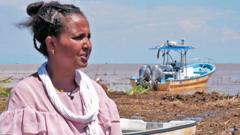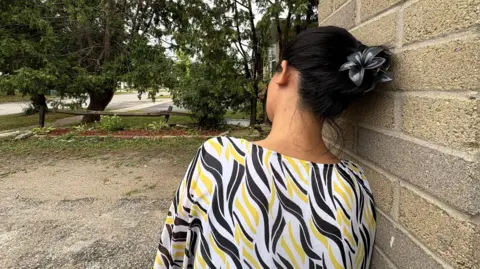Lake Turkana, Kenya - As the sun dipped below the horizon, a haunting scene unfolded as Senait Mebrehtu, a mother from Eritrea, cast flowers onto the shimmering surface of Lake Turkana to honor her 14-year-old daughter, Hiyab, who drowned during a perilous attempt to reach Kenya. Senait, herself a refugee from Eritrea's oppressive regime, made a journey from Nairobi to the lake’s shores wanting to confront the painful realities surrounding her daughter's tragic fate.
Having sought asylum in Kenya three years ago, Senait had initially traveled with her two younger children, while older daughters like Hiyab were left behind due to fears of military conscription. Pressured by the dangerous circumstances in Eritrea, where military service can forcibly stretch for years, Senait's daughters sought to join her through human traffickers, who transported them through harrowing conditions, risking their lives for a chance at freedom.
A smuggler, operating a network across East Africa, acknowledged Lake Turkana’s rising significance as a clandestine crossing point for migrants. After tighter travel restrictions and police patrols on conventional routes, traffickers have increasingly turned to the treacherous waters of the lake. The term "digital route" has emerged among smugglers to describe this new and perilous path.
Witnesses to Hiyab’s tragic drowning recounted the moment their boat capsized, overwhelmed by unforgiving winds, leading to a heartbreaking loss of life with multiple fatalities. Senait condemned the negligence of smugglers, who overloaded boats beyond safe limits. “They put too many people in a small boat that couldn't even carry five,” she lamented, shedding light on the moral failures of traffickers who profit from desperation.
Further adding to the narrative, fishermen working along Lake Turkana reported multiple sightings of bodies, likely those of migrants seeking a better life. Recent UN statistics reveal a staggering 345,000 Eritrean refugees in East Africa, fleeing persecution and strife, with nations like Kenya becoming a preferred destination in the wake of crisis in neighboring areas.
Despite the hazards, some migrants continue to use Kenya as merely a stopover en route to Uganda or beyond, driven by the hope of attaining refugee status. However, the grim realities behind smuggling operations include not just financial exploitation – costing families approximately $5,000 for the journey thus far – but also the threat of physical and emotional abuse faced by women and unaccompanied minors.
Reflecting upon the loss of her daughter, Senait expressed the shared sorrow among Eritrean families caught in cycles of hardship and tragedy. “We have gone through what every Eritrean family is going through,” she noted, encapsulating the fears and struggles of countless individuals seeking safety amid chaos, praying for deliverance from their plight.
Having sought asylum in Kenya three years ago, Senait had initially traveled with her two younger children, while older daughters like Hiyab were left behind due to fears of military conscription. Pressured by the dangerous circumstances in Eritrea, where military service can forcibly stretch for years, Senait's daughters sought to join her through human traffickers, who transported them through harrowing conditions, risking their lives for a chance at freedom.
A smuggler, operating a network across East Africa, acknowledged Lake Turkana’s rising significance as a clandestine crossing point for migrants. After tighter travel restrictions and police patrols on conventional routes, traffickers have increasingly turned to the treacherous waters of the lake. The term "digital route" has emerged among smugglers to describe this new and perilous path.
Witnesses to Hiyab’s tragic drowning recounted the moment their boat capsized, overwhelmed by unforgiving winds, leading to a heartbreaking loss of life with multiple fatalities. Senait condemned the negligence of smugglers, who overloaded boats beyond safe limits. “They put too many people in a small boat that couldn't even carry five,” she lamented, shedding light on the moral failures of traffickers who profit from desperation.
Further adding to the narrative, fishermen working along Lake Turkana reported multiple sightings of bodies, likely those of migrants seeking a better life. Recent UN statistics reveal a staggering 345,000 Eritrean refugees in East Africa, fleeing persecution and strife, with nations like Kenya becoming a preferred destination in the wake of crisis in neighboring areas.
Despite the hazards, some migrants continue to use Kenya as merely a stopover en route to Uganda or beyond, driven by the hope of attaining refugee status. However, the grim realities behind smuggling operations include not just financial exploitation – costing families approximately $5,000 for the journey thus far – but also the threat of physical and emotional abuse faced by women and unaccompanied minors.
Reflecting upon the loss of her daughter, Senait expressed the shared sorrow among Eritrean families caught in cycles of hardship and tragedy. “We have gone through what every Eritrean family is going through,” she noted, encapsulating the fears and struggles of countless individuals seeking safety amid chaos, praying for deliverance from their plight.





















